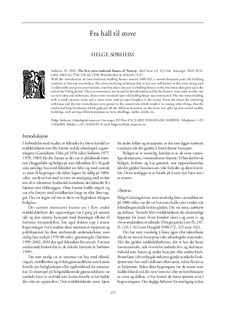| dc.description.abstract | With the introduction of cross-timbered dwelling houses around 1000 AD, a several thousand years old building
tradition in Norway was broken. The cross-timbering technique that in fact was well known at this time, being used
in older wells and grave constructions, was first taken into use in dwelling houses in the new towns that grew up at the
end of the Viking period. The new townsmen, not bound by the old traditions like the farmers, were ready to take into
use new ideas and techniques. Soon a new «standard type» of dwelling house was constructed: The two-room building
with a small entrance room and a main room with an open fireplace in the corner. From the towns the timbering
technique and the two room-houses were spread to the countryside which resulted in, among other things, that the
traditional long farmhouse which gathered all the different functions on the farm, was split up into several smaller
buildings, each serving different purposes as barn, dwellings, stable, smithy etc. | no_NO |
